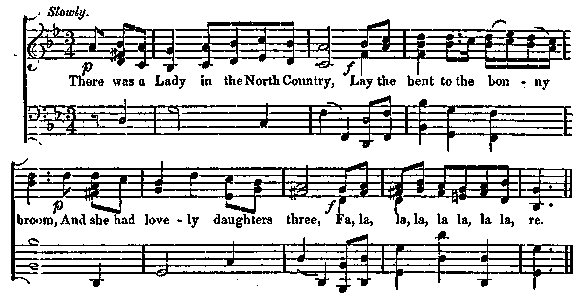Popular Music Of The Olden Time Vol 2
Ancient Songs, Ballads, & Dance Tunes, Sheet Music & Lyrics - online book
| Share page | Visit Us On FB |
|
REIGN OF CHARLES II. 531 |
|||
|
The copy in the Halliwell Collection was printed for F. Coles, T. Vere, and W. Gilbertson, who all commenced publishing before the Restoration. It is in W. Thackeray's list of ballads, and the copy in the Douce Collection was printed by Thomas Norris, at the Looking-glass on London Bridge.
I imagine it to be of earlier date than any copy I have found, and probably derived from a minstrel ballad. The late T. Dibdin informed me that the tune was introduced as a duet in O'Keefe's comedy, The Highland. Reel, in 1788. I have not seen that copy. |
|||
|
|
|||
 |
|||
|
|
|||
|
There was a knight of noble worth,
Lay the bent, Sjc. Who also lived in the North, Fa, la, %c. This knight, of courage stout and brave, A wife he did desire to have ; |
He knocked at the lady's gate,
One evening when it was late.
The eldest sister let him in,
And pinn'd the door with a silver pin. |
||
|
|
|||
|
The knight offers to marry the youngest, if her wit should equal her good looks; and, to test it, proposes to ask three questions. |
|||
|
|
|||
|
" Kind sir, in love, O then," quoth she, " Tell me what your three questions be ?' " O what is longer than the way, Oi' what is deeper than the sea, |
And hunger's sharper than a thorn ; And poison's greener than the grass, And the Devil'u worse than woman was.! When she these questions answered had,
The knight became exceeding glad__
And after, as 'tis verified,
He made of her his lovely bride.
So now, fair maidens all, adieu,
This song I dedicate to you,
And wish that you may constant prove.
Unto the man that you do love. |
||
|
Or what is louder than a horn, Or what is sharper than a thorn, Or what is greener than the grass, Or what is worse than woman was ? " " O love is longer than the way, And hell is deeper than the sea, And thunder's louder than the horn, |
|||
|
COME, LASSES AND LADS. The earliest, copy I have found of this still popular ballad is in Westminster Drollery, Part II., 1672, entitled "The rural dance about the May-pole: The tunc, the first Figure-Dance at Mr. Young's Ball, in May '71." It is also printed with the tune (but the words much altered and abbreviated) in Pills to purye Melancholy, vol. i. of the early editions, and vol. iii. of 1719. The copy in Tixall Poetry, 4to., 1813, taken from an old manuscript, contains a final stanza not to be found in Westminster Drollery.
2 M |
|||
|
|
|||